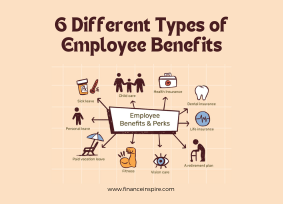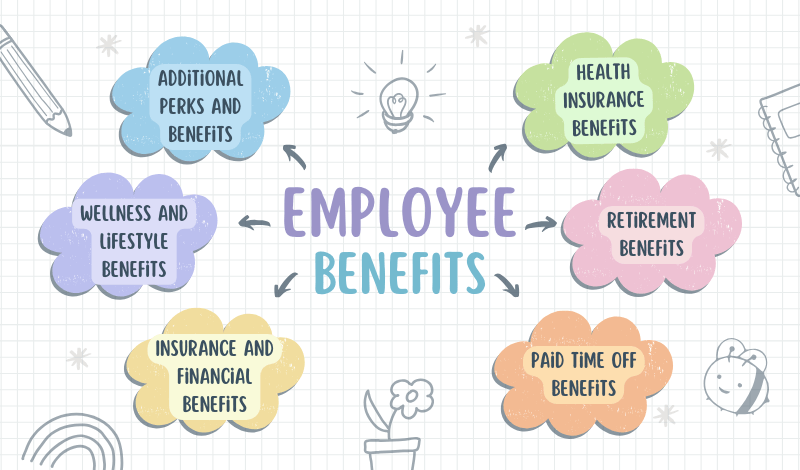Exploring 6 Different Types of Employee Benefits: A Comprehensive Guide
In today’s competitive job market, employee benefits have become a critical factor in attracting and retaining top talent. Beyond just offering a competitive salary, organizations must provide a comprehensive benefits package that caters to the diverse needs and preferences of their workforce. From traditional healthcare coverage to innovative perks and wellness programs, the range of employee benefits available is vast and ever-evolving. In this comprehensive article, we’ll delve into the 6 Different Types of Employee Benefits, empowering you to make informed decisions when evaluating job offers or optimizing your organization’s benefits strategy.
1. Health Insurance Benefits: One of the 6 Different Types of Employee Benefits
One of the most sought-after and essential employee benefits, part of the 6 Different Types of Employee Benefits, is health insurance. A robust health insurance plan can provide peace of mind and financial security for employees and their families, covering a wide range of medical expenses.
1. Medical Insurance: This type of insurance covers expenses related to doctor visits, hospital stays, surgeries, and other medical treatments.
2. Dental Insurance: Dental insurance helps employees manage the costs associated with routine dental care, such as cleanings, fillings, and more complex procedures.
3. Vision Insurance: Vision insurance covers the costs of routine eye exams, glasses, contact lenses, and other vision-related expenses.
2. Retirement Benefits
Preparing for retirement is a crucial consideration for employees, and employers can offer a variety of retirement benefits, which are part of the 6 Different Types of Employee Benefits, to help their workforce plan for the future.
1. 401(k) Plans: These tax-advantaged retirement savings plans allow employees to contribute a portion of their pre-tax income, with many employers offering matching contributions.
2. Pension Plans: Traditional pension plans, also known as defined benefit plans, provide employees with a guaranteed retirement income based on their years of service and salary.
3. Profit-Sharing Plans: With these plans, employers contribute a percentage of the company’s profits to employees’ retirement accounts, providing an additional incentive for their workforce.
3. Paid Time Off Benefits
Striking a healthy work-life balance is essential for employee well-being and productivity. Paid time off benefits, which are part of the 6 Different Types of Employee Benefits, provide employees with opportunities to rest, recharge, and attend to personal or family obligations.
1. Vacation Time: Most employers offer a certain number of paid vacation days per year, allowing employees to take time off for travel, leisure, or personal reasons.
2. Sick Leave: Sick leave benefits enable employees to take paid time off when they or a family member are ill, without fear of losing income or job security.
3. Parental Leave: Parental leave policies provide new parents with paid time off to care for and bond with their newborn or adopted child.
4. Insurance and Financial Benefits
Beyond health and retirement benefits, which are part of the 6 Different Types of Employee Benefits, employers may offer a range of additional insurance and financial benefits to support their employees’ overall well-being.
1. Life Insurance: Life insurance policies provide financial protection for an employee’s beneficiaries in the event of their death.
2. Disability Insurance: Disability insurance provides income replacement for employees who become unable to work due to an illness or injury.
3. Tuition Assistance: Tuition assistance programs help employees further their education and professional development by covering a portion or the full cost of tuition for job-related courses or degrees.
5. Wellness and Lifestyle Benefits
In recent years, organizations have increasingly recognized the importance of promoting employee well-being and work-life balance. As a result, many employers now offer a variety of wellness and lifestyle benefits, which are part of the 6 Different Types of Employee Benefits.
1. Fitness and Gym Memberships: These benefits provide employees with access to fitness facilities, classes, or discounted gym memberships, encouraging a healthy and active lifestyle.
2. Employee Assistance Programs (EAPs): EAPs offer confidential counseling, resources, and support services to help employees manage personal or work-related challenges, such as stress, mental health issues, or financial concerns.
3. Flexible Work Arrangements: Flexible work arrangements, such as remote work options, compressed workweeks, or flexible schedules, can help employees achieve a better work-life balance.
6. Additional Perks and Benefits
To stand out in a competitive job market and cater to the diverse preferences of their workforce, many employers offer a range of additional perks and benefits, which are part of the 6 Different Types of Employee Benefits.
1. Commuter Benefits: These benefits may include subsidized parking, public transportation passes, or reimbursement for commuting expenses.
2. Professional Development Opportunities: Employers may provide opportunities for employees to attend conferences, workshops, or training programs to enhance their skills and knowledge.
3. Employee Discounts: Many organizations offer discounts on products or services, either their own or through partnerships with other companies.
Tailoring Employee Benefits to Your Workforce
While the types of employee benefits listed above are common in the section “6 Different Types of Employee Benefits,” it’s important to recognize that every organization and workforce is unique. Effective benefits packages should be tailored to meet the specific needs and preferences of an organization’s employees, taking into account factors such as demographics, industry, and company culture.
Employers can conduct employee surveys, focus groups, or market research to gain insights into the benefits that are most valued by their workforce in relation to the “6 Different Types of Employee Benefits.” Additionally, regularly reviewing and adjusting benefits offerings can help ensure they remain competitive and aligned with evolving employee needs and industry trends.
Conclusion
Employee benefits play a crucial role in attracting, retaining, and motivating top talent in today’s competitive job market. From traditional healthcare and retirement benefits to innovative wellness programs and lifestyle perks, the range of offerings available is diverse and continually evolving, as highlighted in the section “6 Different Types of Employee Benefits.”
By understanding the different types of employee benefits outlined in the section “6 Different Types of Employee Benefits” and tailoring offerings to meet the unique needs of their workforce, organizations can create a compelling total rewards package that not only supports employee well-being but also fosters a positive and productive work environment.
Employees, on the other hand, should carefully evaluate and compare the benefits packages offered by potential employers, including the “6 Different Types of Employee Benefits,” to ensure they align with their personal and professional goals. By making informed decisions and negotiating for comprehensive benefits, employees can secure the support and resources they need to thrive both in their careers and in their personal lives.











